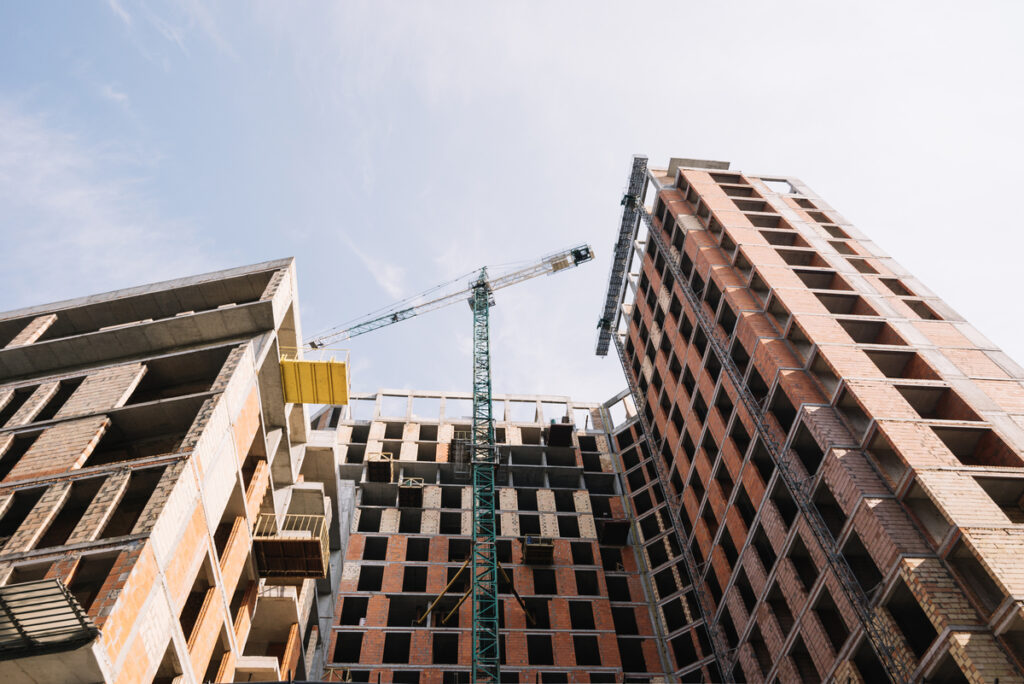Exclusive Neuroject Article: The crucial significance of supply chain management in construction in the constantly changing world, where projects entwine complexity and innovation, has never been more apparent. As 2024 progresses, it is becoming increasingly important to maximize resource allocation, anticipate disruptions, and streamline operations throughout the building supply chain.
The management of a construction supply chain requires careful planning, teamwork, and a thorough awareness of both industry dynamics and cutting-edge technologies. This is true from procuring raw materials to coordinating their flawless delivery, from demand projection to risk reduction. This thorough article takes readers on a trip through the complexities of supply chain management in construction, arming them with the information they need to overcome obstacles, grasp chances, and promote an adaptable and resilient construction ecosystem.
Table of Contents
Introduction to Supply Chain Management in Construction
Supply chain management (SCM) is a key idea that is essential to the development of the construction sector. Its many facets include the planning, acquiring, moving, and coordinating of different resources needed for construction projects. SCM essentially acts as the framework for ensuring the smooth movement of goods, data, and services from suppliers to consumers, hence optimizing project schedules, costs, and quality.
Effective supply chain management in construction becomes crucial in the dynamic industry of construction, where projects frequently require detailed timeframes, many partners, and complex logistics. The supply chain for the construction industry consists of a network of suppliers, manufacturers, distributors, contractors, and subcontractors that all collaborate to deliver the necessary goods and services at the right time. To avoid expensive delays, cut down on waste, and keep projects on time, orchestration is crucial.
Furthermore, SCM in the construction industry goes beyond only purchasing materials. It also includes managing equipment, technology, human resources, and even regulatory compliance. Delivering projects on time and under budget requires making sure that each of these components is in line with project objectives.
Challenges have also surfaced as the construction sector faces fast improvements. These issues include labor shortages and the demand for sustainable practices, as well as fluctuating material prices and supply chain interruptions brought on by unforeseen events. To successfully traverse these issues, construction professionals now absolutely must be proficient in supply chain management in construction techniques.
Understanding the importance of supply chain management in construction execution begins with its debut in the construction industry. SCM is the foundation that determines the construction landscape, from its part in maximizing resource flow to its effect on project success. This article will go deeper into the topic and examine the essential elements, difficulties, best practices, technology advancements, and emerging trends that will define supply chain management in the construction industry in 2024 and beyond.

Importance of Supply Chain Management in Construction
The construction business relies heavily on supply chain management in construction to make sure that goods, resources, and information are delivered without delay from suppliers to the construction site. Its significance cannot be understated because it has a direct impact on project costs, deadlines, and success. The following are the main justifications for why supply chain management in construction is so important in the construction industry:
1. Timely Project Completion:
By ensuring that supplies and resources arrive on time, efficient supply chain management in construction enables construction projects to stay on schedule. Missed deadlines, increased labor expenses, and project failures might result from late material deliveries.
2. Cost Efficiency:
By lowering extra inventory, removing inefficiencies, and improving transportation routes, a well-optimized supply chain reduces costs. The overall financial stability of construction projects is a result of this.
3. Risk Mitigation:
Risks in the construction sector include labor shortages, weather-related delays, and supply interruptions. Proactive risk detection and the implementation of backup plans to lessen their effects are made possible by an effective supply chain.
4. Resource Allocation:
Good supply chain management in construction strategy makes resource allocation more efficient. Construction organizations can prevent resource shortages and overages by comprehending project demands and matching them with the available resources.
5. Customer Satisfaction:
Client satisfaction depends heavily on timely project completion and high-quality results. A streamlined supply chain guarantees that resources are available when required, increasing the likelihood that client expectations will be met or surpassed.
6. Collaboration:
Collaboration among all stakeholders, including suppliers, contractors, and project teams, is facilitated by effective supply chain management in construction. Smoother project execution is a result of improved cooperation and communication.
7. Competitive Advantage:
Strong supply chain management in construction gives construction companies a competitive advantage. They are better able to adapt to changing conditions, respond more quickly to market demands, and obtain contracts thanks to their reliable reputation.
8. Sustainability:
Goals for sustainability are also compatible with supply chain management in construction. Construction firms can lessen their carbon footprint and support environmental conservation by streamlining transportation routes and minimizing surplus inventory.
Successful construction projects are built on solid supply chain management in construction strategy. Its effects are felt in a variety of areas, including project costs, risk management, teamwork, and general customer satisfaction. Effective supply chain management in construction strategies will remain crucial for attaining short- and long-term project goals as the construction sector develops.
Suggested article for reading: Construction Risks

Key Components of Supply Chain Management in Construction
Successful supply chain management in construction is essential to the accomplishment of building projects. The essential elements of supply chain management in construction work in harmony to speed up procedures, improve project results, and cut costs. Construction industry experts can make wise decisions and improve their supply chain strategies by being aware of the significance of these components.
Supplier Management
A successful supply chain is built on effective supplier management. Selecting dependable suppliers minimizes the possibility of delays and disruptions by ensuring a steady flow of high-quality materials. Building trusting connections with suppliers encourages cooperation, which improves negotiation conditions and gives you priority in times of shortage. Deliveries from suppliers on time keep projects on schedule and keep customers satisfied by preventing material shortages from delaying building projects.
Inventory Management
A careful balance must be struck between reducing surplus inventory and keeping adequate resources on hand to meet project demands. Just-in-time methods keep building sites productive without spending money on storage or locking up resources in excess materials. Construction organizations can increase their cash flow and general project efficiency by precisely estimating material requirements and eliminating excess.
Logistics and Transportation
To guarantee that supplies and equipment arrive at the construction site in a timely way, effective logistics and transportation are essential. Transit times and related expenses are decreased by optimizing transportation options and routes. By putting in place optimized transportation procedures, the danger of delays is reduced and costly project schedule disruptions are avoided.
Demand Forecasting
The risk of material shortages or wastage is reduced by precise demand forecasting. Construction organizations can more accurately predict their material needs by looking at previous data and project plans. Enhancing adaptability and lowering the likelihood of disruptions brought on by unforeseen changes in demand can both be accomplished by adjusting projections in response to project modifications and external influences.
Risk Management
The supply chains in the construction sector are vulnerable to a number of threats. Identification of potential disruptions, the creation of backup plans, and the implementation of techniques to lessen their effects are all necessary components of effective risk management. Construction organizations can reduce the chance of project delays, cost overruns, and other negative outcomes by proactively addressing risks.
Construction professionals may strategically manage their supply chains and ensure smoother operations, on-time project completions, and higher customer satisfaction by recognizing the importance of these components.
Challenges in Supply Chain Management in Construction
Construction projects must manage their supply chains effectively in order to succeed, but there are numerous difficulties that the sector must overcome. These difficulties result from the complexity of building projects, which include a variety of stakeholders, flexible project scopes, and outside variables. Here are some major difficulties in supply chain management in construction:
Weather-Related Delays: Weather changes have the potential to delay material deliveries and on-site operations on construction projects. Unpredictable weather conditions, such as storms, hurricanes, and extremely high temperatures, can affect project schedules and costs while also impeding transportation.
Labor Shortages: Lack of skilled labor is a common problem in the construction sector, which causes delays in project completion. Construction organizations may find it difficult to meet project needs when labor resources are limited, which could have an impact on overall efficiency and possibly result in cost overruns.
Regulatory and Compliance Challenges: Construction requires strict adherence to laws, norms, and standards. Regulations are complicated and constantly changing, which can cause delays and extra expenditures. Finding materials that match these requirements can be difficult, especially when working with numerous suppliers.
Supply Chain Fragmentation: Because there are so many suppliers, subcontractors, and other stakeholders involved in the construction industry, supply chains can become disjointed. This fragmentation may cause coordination problems, communication breakdowns, and challenges with supply chain integration.
Limited Visibility and Communication: Making wise decisions might be hampered by a lack of visibility throughout the supply chain. Miscommunication and disruptions may result from a lack of real-time information about material availability, shipment status, and project modifications.
Project Scope Changes: Construction projects frequently have their scope altered as a result of unforeseen events, client requests, or design adjustments. It can be difficult to maintain an effective supply chain when these changes have an impact on material requirements, lead times, and procurement methods.
Global Supply Chain Disruptions: Materials for the construction sector are supplied from numerous places. Global occurrences including trade disagreements, geopolitical unrest, and the COVID-19 pandemic have shown supply chain weaknesses that have resulted in delays and shortages.
Inaccurate Demand Forecasting: For procurement to be in line with project objectives, accurate demand forecasting is essential. However, erroneous estimates may result in material surpluses or shortages, which could affect project budgets and schedules.
Construction organizations must use technology to improve supply chain management in construction and implement proactive tactics to meet these difficulties. These difficulties on construction projects can be lessened by stakeholder cooperation, the incorporation of technological solutions, and emergency preparation.

Best Practices in Supply Chain Management
Construction project success depends on efficient supply chain management in construction. Best practices implementation guarantees that resources are available when required, expenditures are reduced, and project deadlines are fulfilled. Here are some essential supply chain management best practices for the building sector:
Collaborative Project Planning: Participate in the planning process with all parties involved, including clients, suppliers, contractors, and designers. Collaboration in planning encourages open communication, harmonizes expectations, and spots any stumbling blocks in advance.
Cloud-Based Supply Chain Systems: Centralize supply chain data and streamline communication by using cloud-based technologies. This technology improves real-time visibility by enabling teams to access information from any place, which promotes faster decision-making.
Communication and Information Sharing: Create routes for regular communication between project teams. It helps to coordinate efforts and reduce risks when accurate and timely information regarding project needs, modifications, and potential disruptions is shared.
Sustainable Practices: Supply chain management in construction practices should be sustainable. This entails locating eco-friendly resources, cutting waste, and encouraging ethical procurement methods. Sustainability has a positive impact on the environment as well as on finances and reputation.
Supplier Relationship Management: Establish solid connections with suppliers that are founded on openness and trust. Evaluate supplier performance on a regular basis, and promote open communication to discuss issues and spot possibilities for improvement.
Just-in-Time Inventory: To reduce excess inventory and related carrying costs, use just-in-time inventory solutions. By ensuring that goods arrive exactly when needed, this strategy eliminates the need for large amounts of storage space and associated waste.
Technology Integration (IoT and BIM): Utilize the Internet of Things (IoT) to track supplies and machinery in real-time. Supply chain data and building information modeling (BIM) integration improve demand forecasting accuracy and facilitate more efficient resource allocation.
Risk Management: Develop backup plans to handle disruptions and identify potential hazards in the supply chain. Regularly assess risks and make sure that mitigating measures are in place to reduce project delays.
Together, these industry-best practices support effective supply chain management in construction, which enhances project results and lowers project costs.
Suggested articles for reading: BIM in Construction | IoT in Construction
Technological Advancements in Supply Chain Management
Technology has made major strides recently that are changing how supply chain management in construction is addressed in the construction business. These developments are tackling persistent issues in the sector while also improving efficiency and accuracy.
Internet of Things (IoT): To build a more connected and data-driven supply chain, IoT technology is being used. Real-time tracking and monitoring of the movement and condition of commodities, equipment, and vehicles are made possible by sensors and devices placed in these items. Better supply chain visibility is made possible as a result, allowing for prompt intervention and proactive decision-making. For instance, project managers may track shipments, check inventory levels, and improve material flow across the supply chain with the help of RFID tags and GPS trackers on building materials.
Building Information Modeling (BIM) Integration: Supply chain management in construction procedures is being combined with BIM, a digital representation of a building’s structural and functional attributes. BIM makes it possible to visualize construction projects accurately and helps with demand forecasting. Construction specialists may identify the materials needed at each step of the project by studying the BIM model, resulting in optimized procurement and decreased waste. The right documents are always available at the appropriate moment thanks to this integration, which also improves stakeholder collaboration.
Drones and Robotics: In building supply chains, drones are revolutionizing site inspections, inventory control, and logistics. Large construction sites may be quickly surveyed by drones with cameras and sensors, which can also be used to track development and spot potential problems. They offer useful information that helps with decision-making and averts delays. Robotics is also utilized to automate operations like material handling, which reduces labor-intensive procedures and improves operational effectiveness.
The supply chain for construction has greatly benefited from these technical developments. Project completion on schedule and cost reductions are facilitated by increased visibility, precise demand forecasts, and optimized logistics. To properly utilize these advancements, however, issues like data security, integration difficulties, and the requirement for worker upskilling must be addressed.
Suggested articles for reading: Drones in Construction | Construction Robots

Conclusion
This thorough book has delved into the complex world of supply chain management in construction within the construction industry, illuminating its essential function in project success. The many aspects of supplier management, inventory control, logistics, demand forecasting, and risk mitigation are examined in detail so that construction professionals can gain the knowledge necessary to negotiate the intricate web of problems that frequently plague supply chains.
It is abundantly evident that a well-organized supply chain has the ability to significantly speed up project completion times, cut expenses, and increase resistance to disruptions. It is impossible to exaggerate how crucial collaborative planning, the use of cutting-edge technologies, and adherence to sustainable practices are to creating a supply chain ecosystem that is efficient and future-proof.
Incorporating disruptive technologies like blockchain, AI-driven analytics, and sustainable sourcing is primed to revolutionize the landscape as we look into the future of supply chain management in construction. These trends will enable industry experts in construction to proactively grab opportunities and anticipate obstacles. The construction sector is on the cusp of an era where supply chain management in construction is not only an operational necessity but also a strategic differentiator through fostering a synergy between stakeholders and utilizing cutting-edge solutions.
Suggested article for reading:
important construction technology in 2024
7 Important Building Technology Ideas for 2024
Resources:
Cemex Ventures | Tourner & Townsend | The Constructor | Builder Space | Builder Trend | Assigner | Blue Ociean Acadamy | IT Supply Chain
Journal Articles:
- Ahi, P., & Searcy, C. (2013). A comparative literature analysis of definitions for green and sustainable supply chain management. Journal of Cleaner Production, 52, 329-341.
- Akbarnezhad, A., & Zavadskas, E. K. (2016). A multi-objective model for the selection of suppliers in the construction industry using BIM and fuzzy TOPSIS. Sustainability, 8(10), 1026.
- Construction Industry Institute. (2023). “Supply Chain Management Best Practices in Construction.” CII Research Report RR-374.
- Global Construction Trends Report. (2023). XYZ Consulting Group.
- Green, S. et al. (2022). “Sustainable Sourcing Strategies in Construction: A Path Towards Resilient Supply Chains.” Journal of Sustainable Construction, 17(1), 45-60.
- Ivanov, D., & Tsipoulanidis, A. (2017). “Global supply chain planning in the era of Industry 4.0: Overview and challenges.” The International Journal of Advanced Manufacturing Technology, 91(1-4), 283-305.
- Johnson, L. et al. (2021). “The Role of Technology in Enhancing Construction Supply Chains.” International Journal of Construction Engineering, 8(2), 120-138.
- Kiviniemi, A. O. (2017). Challenges and opportunities of the utilization of BIM in construction projects. Procedia Engineering, 196, 125-132.
- Lu, W., Lu, M., Cheung, S. O., & Ho, C. M. F. (2019). Implementation of RFID in construction projects: An exploratory study. Automation in Construction, 104, 166-175.
- O’Brien, W. J., & Fischer, M. (2015). Integrating supply chain and project management concepts: Towards delivering better customer value. International Journal of Project Management, 33(1), 61-73.
- Rahimi, F., Yadav, O. P., & Klassen, R. D. (2018). Sustainable supply chain management in the oil and gas industry: An in-depth analysis. International Journal of Production Economics, 205, 79-96.
- Schulte, R., & Spang, K. (2020). Disruption and resilience in supply chains: A research agenda. International Journal of Operations & Production Management, 40(3), 262-290.
- Smith, J. (2022). “Optimizing Supply Chain in Construction: A Comparative Analysis.” Construction Management Journal, 45(3), 67-83.
- Sroufe, R., & Curkovic, S. (2019). “Supply chain flexibility and firm performance: The mediation of strategic supply chain practices.” International Journal of Physical Distribution & Logistics Management, 49(5), 465-485.
- Sun, L., Wang, Y., & Zhang, G. (2019). “The impact of collaborative planning, forecasting and replenishment on supply chain management performance: A systematic review and future directions.” International Journal of Production Economics, 210, 16-31.
For all the pictures: Freepik



